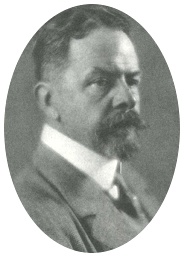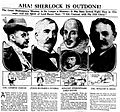George Fabyan facts for kids
"Colonel" George Fabyan (1867 – 1936) was a rich businessman who started a special research lab. This lab, called Riverbank Laboratories, was a pioneer in modern cryptography, which is the study of codes and ciphers. It was even a very early version of what later became the National Security Agency (NSA). The NSA has officially recognized Riverbank Laboratories as the place where U.S. code-breaking began.
Contents
Early Life and Honorary Title
George Fabyan was born in Boston, Massachusetts. He was the second of five children. When he was 17, he left home and eventually moved to Chicago. There, he managed the Chicago office of his father's textile business, Bliss, Fabyan & Co. He later inherited money from this business, which helped him and his wife, Nelle, create their amazing legacy.
In 1901, the Governor of Illinois, Richard Yates, gave George Fabyan the honorary title of "Colonel." This is how he became known.
Fabyan also spent time in Japan before 1905. He built good relationships with the Japanese government and business leaders. Because of this, he was chosen to help during the peace talks between Russia and Japan in 1905. The Japanese government even gave him a special award, the Order of the Rising Sun, in 1909 for his service.
The Riverbank Estate
George and Nelle Fabyan created a large country estate called "Riverbank" in Geneva, Illinois. It was about 40 miles west of Chicago. They started by buying 10 acres of land by the Fox River. Over time, their estate grew to 325 acres!
Their home, the Fabyan Villa, was a remodeled farmhouse where they lived from 1908 to 1939. The estate had many interesting features, including:
- A beautiful Japanese Garden
- A private zoo
- A Roman-style swimming pool
- A lighthouse
- Two windmills
- Gardens and greenhouses
- A farm
- And, of course, their famous research laboratory.
In 1914, Fabyan bought an old Dutch-style windmill built around c. 1870. He had it moved from its original location to his estate. This windmill, known as the Fabyan Windmill, is five stories tall. It was fixed up in 2004 and can grind grain again. Both the laboratory and the windmill are now listed on the National Register of Historic Places.
Solving Shakespeare's Secrets
George Fabyan was interested in a popular idea at the time called the Baconian theory. This theory suggested that the famous plays by William Shakespeare were actually written by Francis Bacon. Fabyan believed this idea and set up a special group at his Riverbank Laboratories to look for secret codes in Shakespeare's writings. This was the first private research center in the United States.
In 1916, a film producer named William Nicholas Selig sued Fabyan. Selig said that Fabyan's claims about Bacon writing Shakespeare would hurt the profits from his upcoming Shakespeare films. A judge first sided with Fabyan, saying that the secret codes found by Fabyan's expert, Elizabeth Wells Gallup, were real. The judge even said that Francis Bacon was the true author! However, this decision caused a lot of discussion, and it was quickly changed. Another judge later dismissed the ruling. Some people thought the whole case might have been set up by Fabyan and Selig, who were old friends, just to get publicity.
Fabyan hired Elizebeth Smith, who was a Shakespeare expert, to work with Gallup. Later, a geneticist named William Friedman also joined the lab. He started as a photographer but soon became very involved in code-breaking. He eventually led the Codes & Ciphers department at Riverbank.
Both Elizebeth and William Friedman became incredibly important in the field of cryptanalysis, which is the science of breaking codes. William even came up with the word "cryptanalysis"! Their work at Riverbank Laboratories became the foundation for what would later become the National Security Agency (NSA). Years later, William and Elizebeth wrote a book together that proved the secret codes Gallup claimed to find were not real. This book won an award in 1955 and is considered the final word on the topic, showing that Shakespeare's works do not contain hidden messages about who wrote them.
World War I and Code-Breaking
The Friedmans played a huge role during World War I. Almost all of the American military's code-breaking during the war happened at Fabyan's laboratories. For example, they uncovered a secret plan against the British by Indian nationalists who were supported by the Germans.
The National Security Agency has recognized Riverbank Laboratories as the birthplace of U.S. cryptology. In 1992, they honored Fabyan with a special plaque. It thanked him and his lab for their secret and important work in code-breaking and training during a crucial time before America joined World War I.
Death and Legacy
George Fabyan passed away in 1936. He left money to his wife, Nelle, and a monthly payment to his secretary. After his death, Nelle burned some of his papers, as he had asked, even though William Friedman tried to stop her. However, other important papers survived and are now kept at the New York Public Library.
Nelle died in 1939. The estate was then sold to the county and is now part of the Kane County Forest Preserve District. The acoustic laboratory that Fabyan built is still in operation today as the Riverbank Laboratories. His home, the Fabyan Villa, is now a museum. The restored windmill is also open to the public on summer weekends.
Images for kids
-
Newspaper report of the 1916 trial, Chicago Tribune, depicting (left to right) Fabyan, Tuthill, Shakespeare, Selig.




